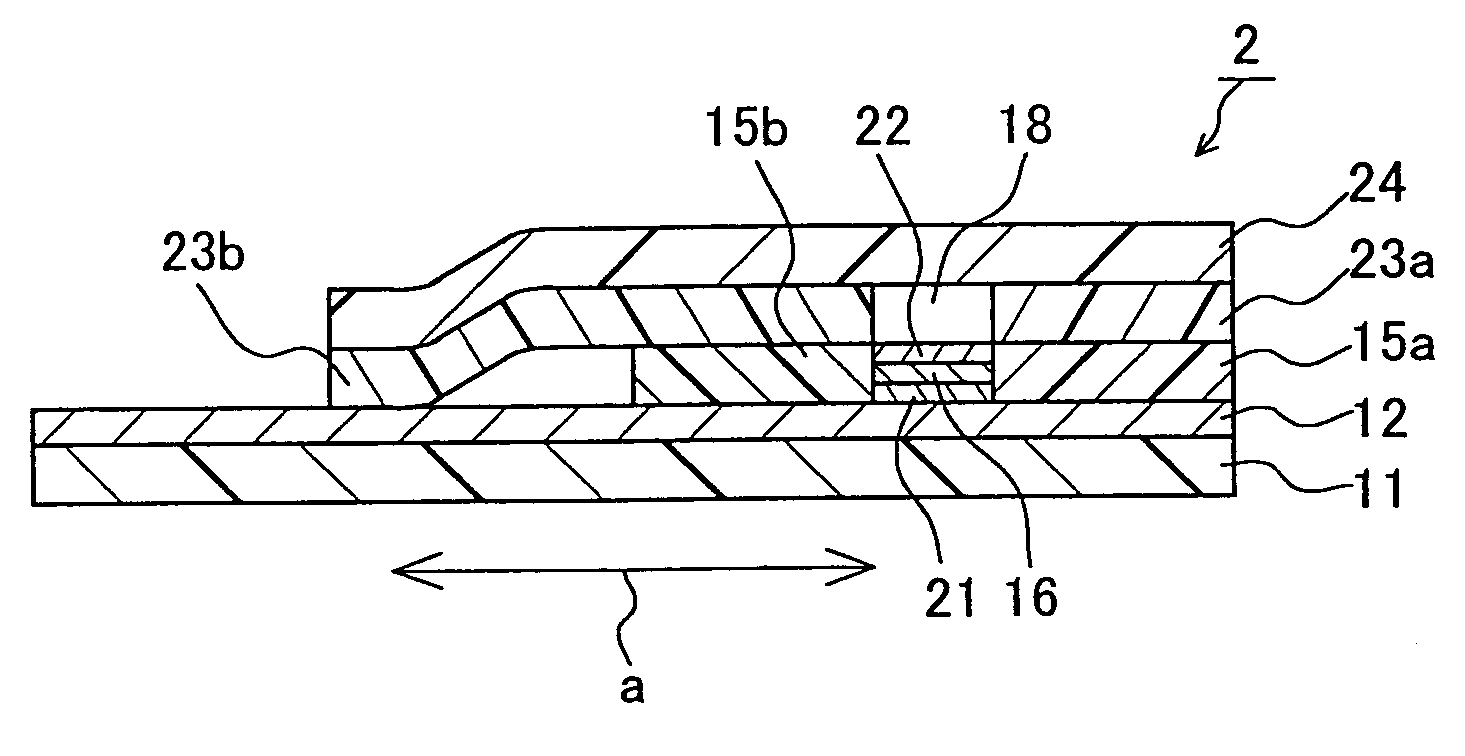Biosensor
a biosensor and sensor technology, applied in the field of biosensors, can solve the problems of inability to absorb water, inability to detect biosensors, and inability to detect biosensors, and achieve the effect of high water absorption
- Summary
- Abstract
- Description
- Claims
- Application Information
AI Technical Summary
Benefits of technology
Problems solved by technology
Method used
Image
Examples
embodiment 1
(Embodiment 1)
[0039]FIGS. 1A–1C show an example of a biosensor of the present invention. FIG. 1A is a plan view of the biosensor, FIG. 1B is a cross-sectional view taken along the line I—I of FIG. 1A, and FIG. 1C is a cross-sectional view taken along the line II—II of FIG. 1A. As shown in the drawings, in this biosensor 1, an electrode system including a working electrode 12 and counter electrodes 13 is disposed on a substrate 11. A reagent layer 16, which is a single layer containing a reagent and particulates, is formed on one end portion (on the right side of FIG. 1A, and at the upper right of FIG. 1B) of the electrode system. The two counter electrodes 13 are disposed on the opposite ends in the width direction (the direction indicated by the arrow “b”) of the substrate 11, and the working electrode 12 is disposed in the center in the width direction of the substrate 11. These electrodes 12 and 13 extend in the longitudinal direction (the direction indicated by the arrow “a”) of...
embodiment 2
(Embodiment 2)
[0069]FIGS. 2A–2C show another example of a biosensor of the present invention. FIG. 2A is a plan view of the biosensor, FIG. 2B is a cross-sectional view taken along the line III—III of FIG. 2A, and FIG. 2C is a cross-sectional view taken along the line IV—IV of FIG. 2A. In FIGS. 2A–2C, the same components as those in FIGS. 1A–1C bear the same reference numeral.
[0070]As shown in the drawings, in this biosensor 2, an electrode system including a working electrode 12 and counter electrodes 13 is disposed on a substrate 11. A laminate, in which an inorganic gel-containing layer 21, a reagent layer 16, and a surfactant-containing layer 22 are laminated in this order, is formed on one end portion (at the upper right of FIGS. 2A and 2B) of the electrode system. The reagent layer 16 contains a reagent and particulates. The two counter electrodes 13 are disposed on the opposite ends in the width direction (the direction indicated by the arrow “b”) of the substrate 11, and the...
embodiment 3
(Embodiment 3)
[0077]This embodiment is an example of the biosensor of the present invention in which a reagent layer is a laminate including a reagent-containing layer and a particulate-containing layer. FIG. 3 is a cross-sectional view of this biosensor. In FIG. 3, the same components as those in FIGS. 1A–1C bear the same reference numeral.
[0078]As shown in FIG. 3, the biosensor 3 has the same configuration as in Embodiment 1, except that a particulate-containing layer 32 is laminated on the substrate 11, on which the electrodes have been disposed, via a reagent-containing layer 31. The reagent-containing layer 31 and the particulate-containing layer 32 can be formed in the following manner, for example. First, a solution containing a reagent and a solution containing particulates are prepared. The solution containing the reagent is poured into the space between the spacers and dried, and thereafter, the solution containing the particulates is poured thereon and dried.
[0079]In this...
PUM
| Property | Measurement | Unit |
|---|---|---|
| particle diameter | aaaaa | aaaaa |
| particle size distribution | aaaaa | aaaaa |
| particle diameter | aaaaa | aaaaa |
Abstract
Description
Claims
Application Information
 Login to View More
Login to View More - R&D
- Intellectual Property
- Life Sciences
- Materials
- Tech Scout
- Unparalleled Data Quality
- Higher Quality Content
- 60% Fewer Hallucinations
Browse by: Latest US Patents, China's latest patents, Technical Efficacy Thesaurus, Application Domain, Technology Topic, Popular Technical Reports.
© 2025 PatSnap. All rights reserved.Legal|Privacy policy|Modern Slavery Act Transparency Statement|Sitemap|About US| Contact US: help@patsnap.com



